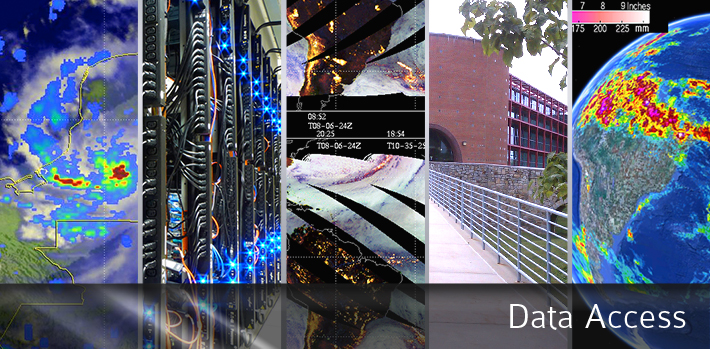
How to Access TRMM & GPM Precipitation Data
Precipitation data from the GPM and TRMM missions is made available free to the public in a variety of formats from several sources at NASA Goddard Space Flight Center. This section outlines the different types of data available, the levels of processing, the sources to download the data, and some helpful tips for utilizing precipitation data in your research.
-
GPM Data Downloads & Documentation
-
TRMM Data Downloads & Documentation
-
Training Resources
-
Data Visualization Tools
-
Data Processing "Recipes"
-
Frequency Asked Questions (FAQ)
Questions? Read the Data FAQ
If you still have questions after reading the FAQ, then you may contact us and we will do our best to assist you.
TRMM & GPM Data Policy
TRMM and GPM data are freely available at all levels for which the particular sensor or sensor combination has been processed by GPM. For the GPM Core Observatory this is for Levels 0 through 3 products (as applicable). For the partner satellites in the GPM constellation this is Levels 1c through 3 (as applicable).
Users are encouraged to access data from the primary TRMM and GPM archives (i.e. nasa.gov domains at Goddard Space Flight Center). When data from secondary archives are used, it is incumbent on the user to verify that the data values accessed are accurate, up-to-date, current-version copies of the original data. Data format questions should be directed to the relevant archive site, while science questions should be sent to the dataset developers.
The data set source should be acknowledged when the data are used. One standard format for a formal reference is:
Dataset authors/producers, data release date: Dataset title, version. Data archive/distributor, access date in standard AMS format, data locator/identifier (doi or URL).
For example:
G. Huffman, D. Bolvin, D. Braithwaite, K. Hsu, R. Joyce, P. Xie, 2014: Integrated Multi-satellitE Retrievals for GPM (IMERG), version 4.4. NASA's Precipitation Processing Center, accessed 31 March, 2015, ftp://arthurhou.pps.eosdis.nasa.gov/gpmdata/
For more details on citation format, please refer to the American Meteorologic Society Data Archiving and Citation guidelines: http://www2.ametsoc.org/ams/index.cfm/publications/authors/journal-and-bams-authors/journal-and-bams-authors-guide/data-archiving-and-citation/
In the case of data sets that have not been given DOI’s, the most persistent "landing page" should be named as the "data locator", for example,
http://disc.gsfc.nasa.gov/datacollection/3B42.V7.html
As an “Acknowledgment”, one possible wording is:
"The <dataset name> data were provided by the NASA/Goddard Space Flight Center's <team's organization> and PPS, which develop and compute the <dataset name> as a contribution to <project (TRMM or GPM)>, and archived at the NASA GES DISC."
Finally, dataset users are asked to report errors and difficulties in the dataset to the dataset creators using the contact form below.
Point of Contact
Data Access Frequently Asked Questions
Click here to view the full FAQ
Q: When will GPM data be made available?
A: GPM project data sets, including the Core Observatory and constellation partner sensor data sets, national data sets, including multi-satellite data sets, have been released to the public and are available for download now (click here to see a table of GPM data products). These initial releases are being computed for the GPM era (February 2014 to present) using pre-launch calibrations.
Subsequently, a general reprocessing will upgrade the algorithms to fully GPM-based calibrations. This is scheduled to occur in September 2015 for Core Observatory and partner data sets, and in January 2016 for the U.S. multi-satellite algorithm (Integrated Multi-Satellite Retrievals for GPM; IMERG). After about a year of additional development work, the data sets will be retrospectively processed back to the start of TRMM (January 1998).
Q: What is the spatial and temporal resolution of GPM data?
A: The resolution of Level 0, 1, and 2 data is determined by the footprint size and observation interval of the sensors involved. Level 3 products are given a grid spacing that is driven by the typical footprint size of the input data sets. See the table of GPM & TRMM Data Downloads for details on the resolution of each specific product.
Q: How Do I Get Precipitation Data for my Specific Location?
A: There are several sources for downloading and viewing data which allow you to subset the data by longitude and latitude. These include the Simple Subset Wizard, Giovanni and STORM . In the new Giovanni 4 you can also now obtain data for a specific country, U.S. state, or watershed by using the "Show Shapes" option in the "Select Region" panel.
Q: Where can I find detailed documentation on the precipitation algorithms?
A: Browse our tables of GPM & TRMM data downloads to locate your desired algorithm, then click on the link in the algorithm description that says "Full Documentation".
Q: What will happen to the TRMM Multi-satellite Precipitation Analysis (TMPA / 3B42x) data products?
A: The transition from the Tropical Rainfall Measuring Mission (TRMM) data products to the Global Precipitation Measurement (GPM) mission products has begun. The TMPA products will be replaced by the Integrated Multi-satellitE Retrievals for GPM (IMERG) products. It is tentatively planned to continue computing the TMPA products throughout the transition, into Spring 2017. Click here for more details on this transition. Click here for more details on this transition.
Q: What is the difference between "Realtime" (RT) and "Production" (Prod) data?
A: GPM data products can be divided into two groups (real-time and production) depending on how soon they are created after the satellite collects the observations. For applications such as weather, flood, and crop forecasting that need precipitation estimates as soon as possible, real-time data products are most appropriate. GPM real-time products are generally available within a few hours of observation. For all other applications, production data products are generally the best data sets to use because additional or improved inputs are used to increase accuracy. These other inputs are only made available several days, or in some cases, several months, after the satellite observations are taken, and the production data sets are computed after all data have arrived, making possible a more careful analysis.
Q: Where can I find climatology data?
A: The TRMM FTP has a Climatology directory which contains files in the TRMM Composite Climatology developed by Wang, Adler, Huffman, and Bolvin. A journal article on this topic is available here: http://journals.ametsoc.org/doi/abs/10.1175/JCLI-D-13-00331.1 . Pre-generated world maps of TRMM climatology data are also available here.
Q: Am I allowed to use GPM data for my research?
A: Yes, in line with NASA's general data policy. Please refer to the GPM Data Policy for further details.
Q: How do I give credit for using GPM data?
A: The data set source should be acknowledged when the data are used. One standard format for a formal reference is:
Dataset authors/producers, data release date: Dataset title, version. Data archive/distributor, access date in standard AMS format, data locator/identifier (doi or URL).
For example:
G. Huffman, D. Bolvin, D. Braithwaite, K. Hsu, R. Joyce, P. Xie, 2014: Integrated Multi-satellitE Retrievals for GPM (IMERG), version 4.4. NASA's Precipitation Processing Center, accessed 31 March, 2015, ftp://arthurhou.pps.eosdis.nasa.gov/gpmdata/
For more details on citation format, please refer to the American Meteorologic Society Data Archiving and Citation guidelines: http://www2.ametsoc.org/ams/index.cfm/publications/authors/journal-and-bams-authors/journal-and-bams-authors-guide/data-archiving-and-citation/
In the case of data sets that have not been given DOI’s, the most persistent "landing page" should be named as the "data locator", for example,
http://disc.gsfc.nasa.gov/datacollection/3B42.V7.html
As an “Acknowledgment”, one possible wording is:
"The <dataset name> data were provided by the NASA/Goddard Space Flight Center's <team's organization> and PPS, which develop and compute the <dataset name> as a contribution to <project (TRMM or GPM)>, and archived at the NASA GES DISC."
Read More Data Access Frequently Asked Questions
Use of the PPS FTP and STORM requires you to first register your email address. Click here to register.
QUICK DATA LINKS
DATA NEWS
-
Friday, December 23, 2016Anomalies in the DMSP F-16 input data for the TMPA-RT created streaks of precipitation over open-ocean regions. We have now deleted faulty data and rerun the TMPA-RT for the period: 18 December 2016 at 09 UTC to 19 December 2016 at 18 UTC. Please re-...
-
Tuesday, December 20, 2016PPS received replacement PRL1KA/KU files from JAXA. PPS will reprocess the affected data including combined and downstream products (2AKa, 2AKu, 2ADPR, 2BCMB, 2HCSH, 2HSLH, 3GCSH, 3GSLH) from 2016-12-17 16:31:39 -> 2016-12-17 18:04:13. If you...
-
Tuesday, September 27, 2016We have discovered that the gauge analysis was erroneously omitted from the "production" 3B42/43 products starting with January 2016 due to issues with handling a change of data format. Thus, the production 3B42/43 are being re-computed. ...
-
Monday, September 26, 2016UPDATE 9/27/16: January 2016 IMERG has been regenerated and posted. This was necessary due to an error that omitted the gauge analysis in the Final products. Also, 3B42/3B43 have been recomputed and posted. Let me know if you have any further...

